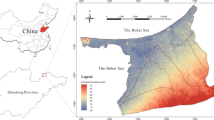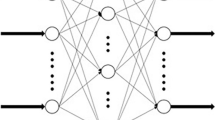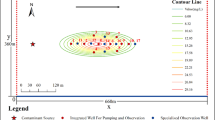Abstract
The simulation-optimization method is widely used in the design of the groundwater pollution monitoring network (GPMN). The uncertainty of the simulation model will significantly affect the design results of GPMN. When the Monte Carlo method is used to consider the influence of model uncertainty on the optimization results, the simulation model needs to be invoked many times, which will cause a huge amount of calculation. To reduce the calculation load, the study proposed to use the support vector regression (SVR) method to construct the surrogate model to couple the simulation model and the optimization model in the optimal design of GPMN. The optimization goal is to maximize the accuracy of the spatial description of pollution plume in each monitoring period. The study also considered the dynamic changes in the migration and morphological of pollution plumes in the optimization of GPMN. Finally, the West Shechang coal gangue pile in Fushun of China was used as a case study to verify the effectiveness of the above method. The results demonstrate that the SVR surrogate model can fit the input-output relationship of the simulation model to a high degree with less computation. The optimized monitoring network can reveal essential and comprehensive information about pollution plumes. The study provides a stable and reliable method for the design of GPMN.









Similar content being viewed by others
References
Alizadeh Z, Mahjouri N (2017) A spatiotemporal Bayesian maximum entropy-based methodology for dealing with sparse data in revising groundwater quality monitoring networks: the Tehran region experience. Environ Earth Sci 76(12):436
Cortes C, Vapnik V (1995) Support-vector networks. Mach Learn 20(3):273–297
Dhar A, Datta B (2007) Multi-objective design of dynamic monitoring networks for detection of groundwater pollution. J Water Resour Plan Manag 133(4):329–338. https://doi.org/10.1061/(ASCE)0733-9496(2007)133:4(329
Dokou Z, Pinder GF (2009) Optimal search strategy for the definition of a DNAPL source. J Hydrol 376(3–4):542–556. https://doi.org/10.1016/j.jhydrol.2009.07.062
Herrera GS, Simuta-Champo R (2012) Optimal design of groundwater-quality sampling networks with three-dimensional selection of sampling locations using an ensemble smoother. J Water Resour Plan Manag 139(6):682–692. https://doi.org/10.1061/(ASCE)WR.1943-5452.0000230
Holland JH (1992) Adaptation in natural and artificial systems: an introductory analysis with applications to biology, control, and artificial intelligence. MIT press
Hou Z, Lu W (2018) Comparative study of surrogate models for groundwater contamination source identification at DNAPL-contaminated sites. Hydrogeol J 26(3):923–932
Hou Z, Lu W, Chen M (2016) Surrogate-based sensitivity analysis and uncertainty analysis for dnapl-contaminated aquifer remediation. J Water Resour Plan Manag 142(11):04016043. https://doi.org/10.1061/(ASCE)WR.1943-5452.0000677
Hou Z, Dai Z, Lao W, Wang Y, Lu W (2019) Application of mixed-integer nonlinear optimization programming based on ensemble surrogate model for dense nonaqueous phase liquid source identification in groundwater. Environ Eng Sci 36(6):699–709
Hu JN et al (2014) State-of-charge estimation for battery management system using optimized support vector machine for regression. J Power Sources 269:682–693. https://doi.org/10.1016/j.jpowsour.2014.07.016
Jin Y (2005) A comprehensive survey of fitness approximation in evolutionary computation. Soft Comput 9(1):3–12
Kollat JB, Reed PM, Maxwell RM (2011) Many-objective groundwater monitoring network design using bias-aware ensemble Kalman filtering, evolutionary optimization, and visual analytics. Water Resour Res 47(2). https://doi.org/10.1029/2010WR009194
Loaiciga HA (1989) An optimization approach for groundwater quality monitoring network design. Water Resour Res 25(8):1771–1782. https://doi.org/10.1029/WR025i008p01771
Luo Q et al (2016) Multi-objective optimization of long-term groundwater monitoring network design using a probabilistic Pareto genetic algorithm under uncertainty. J Hydrol 534:352–363. https://doi.org/10.1016/j.jhydrol.2016.01.009
Meyer PD, Brill ED (1988) A method for locating wells in a groundwater monitoring network under conditions of uncertainty. Water Resour Res 24(8):1277–1282. https://doi.org/10.1029/WR024i008p01277
Nowak W, De Barros FPJ, Rubin Y (2010) Bayesian geostatistical design: task-driven optimal site investigation when the geostatistical model is uncertain. Water Resour Res 46(3):1–17. https://doi.org/10.1029/2009WR008312
Ohmer M, Liesch T, Goldscheider N (2019) On the optimal spatial design for groundwater level monitoring networks. Water Resour Res 55(11):9454–9473
Ouyang Q, Lu W, Hou Z, Zhang Y, Li S, Luo J (2017) Chance-constrained multi-objective optimization of groundwater remediation design at DNAPLs-contaminated sites using a multi-algorithm genetically adaptive method. J Contam Hydrol 200:15–23
Reed P, Minsker B, Valocchi AJ (2000) Cost-effective long-term groundwater monitoring design using a genetic algorithm and global mass interpolation. Water Resour Res 36(12):3731–3741
Smola AJ, Schölkopf B (2004) A tutorial on support vector regression. Stat Comput 14(3):199–222. https://doi.org/10.1023/B:STCO.0000035301.49549.88
Sreekanth J, Datta B (2010) Multi-objective management of saltwater intrusion in coastal aquifers using genetic programming and modular neural network based surrogate models. J Hydrol 393(3–4):245–256. https://doi.org/10.1016/j.jhydrol.2010.08.023
Wagner BJ (1995) Recent advances in simulation-optimization groundwater management modeling. Rev Geophys 33(S2):1021–1028
Whitley D (1994) A genetic algorithm tutorial. Stat Comput 4(2):65–85
Wu J, Zheng C, Chien CC (2005) Cost-effective sampling network design for contaminant plume monitoring under general hydrogeological conditions. J Contam Hydrol 77(1–2):41–65. https://doi.org/10.1016/j.jconhyd.2004.11.006
Xing Z, Qu R, Zhao Y, Fu Q, Ji Y, Lu W (2019) Identifying the release history of a groundwater contaminant source based on an ensemble surrogate model. J Hydrol 572:501–516. https://doi.org/10.1016/j.jhydrol.2019.03.020
Xu T, Gómez‐Hernández JJ (2016) Joint identification of contaminant source location, initial release time, and initial solute concentration in an aquifer via ensemble Kalman filtering. Water Resour Res 52(8):6587–6595
Yang H et al (2004) Outliers treatment in support vector regression for financial time series prediction. International Conference on Neural Information Processing. Springer, Berlin. https://doi.org/10.1007/978-3-540-30499-9_196
Acknowledgments
This study was supported by the National Key Research and Development Program of China (No. 2016YFC0402800), the China Geological Survey (No. DD20160266), Science and Technology Development Project of Jilin Province (No. 20180520092JH), and Key Laboratory of Groundwater Resources and Environment, Ministry of Education, Jilin University, Changchun, China. Special gratitude is given to editors for their efforts on treating and evaluating the work, and the valuable comments of the reviewers are also greatly acknowledged.
Author information
Authors and Affiliations
Corresponding author
Ethics declarations
Conflict of interest
The authors declare that they have no conflict of interest.
Additional information
Responsible editor: Xianliang Yi
Publisher’s note
Springer Nature remains neutral with regard to jurisdictional claims in published maps and institutional affiliations.
Rights and permissions
About this article
Cite this article
Fan, Y., Lu, W., Miao, T. et al. Optimal design of groundwater pollution monitoring network based on the SVR surrogate model under uncertainty. Environ Sci Pollut Res 27, 24090–24102 (2020). https://doi.org/10.1007/s11356-020-08758-5
Received:
Accepted:
Published:
Issue Date:
DOI: https://doi.org/10.1007/s11356-020-08758-5




